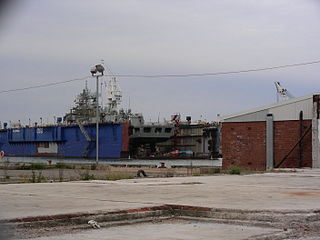
Wallsend, historically Wallsend on Tyne, is a town in the metropolitan borough of North Tyneside, North East of England, in the traditional county of Northumberland. Wallsend derives its name from its location at the eastern end of Hadrian's Wall. It has a population of 42,842 and lies 3.5 miles east of Newcastle City Centre. The population of the Wallsend ward of the North Tyneside Borough was at the 2011 census 10,304.

Harland & Wolff Heavy Industries is a heavy industrial company, specialising in ship repair, conversion, and offshore construction, located in Belfast, Northern Ireland. Harland & Wolff is famous for having built the majority of the ships intended for the White Star Line. Well known ships built by Harland & Wolff include the Olympic-class trio: RMS Titanic, RMS Olympic and RMS Britannic, the Royal Navy's HMS Belfast, Royal Mail Line's Andes, Shaw Savill's Southern Cross, Union-Castle's RMS Pendennis Castle, and P&O's Canberra. Harland and Wolff's official history, Shipbuilders to the World, was published in 1986.

A shipyard is a place where ships are built and repaired. These can be yachts, military vessels, cruise liners or other cargo or passenger ships. Dockyards are sometimes more associated with maintenance and basing activities than shipyards, which are sometimes associated more with initial construction. The terms are routinely used interchangeably, in part because the evolution of dockyards and shipyards has often caused them to change or merge roles.

Charles Mitchell was a Scottish engineer from Aberdeen who founded major shipbuilding yards on the Tyne. He became a public benefactor who funded notable buildings that still survive today.

Swan Hunter, formerly known as Swan Hunter & Wigham Richardson, is a shipbuilding design, engineering, and management company, based in Wallsend, Tyne and Wear, England.
British Shipbuilders Corporation (BS) was a public corporation that owned and managed the shipbuilding industry in Great Britain from 1977 through the 1980s. The British Shipbuilders Corporation headquarters was at Benton House in Newcastle upon Tyne, England.

The Aircraft and Shipbuilding Industries Act 1977 is an Act of the Parliament of the United Kingdom that nationalised large parts of the UK aerospace and shipbuilding industries and established two corporations, British Aerospace and British Shipbuilders (s.1).

John Wigham Richardson was a British shipbuilder on Tyneside during the late 19th and early 20th century.
Point Pleasant is part of the town of Wallsend, Tyne and Wear, England, lying between the town centre and the River Tyne.

John Brown and Company of Clydebank was a Scottish marine engineering and shipbuilding firm. It built many notable and world-famous ships including RMS Lusitania, HMS Hood, HMS Repulse, RMS Queen Mary, RMS Queen Elizabeth and the Queen Elizabeth 2.
Seawind Barclay Curle is a British shipbuilding company.

John Readhead & Sons was a shipyard on the River Tyne in South Shields, Tyne and Wear, England.

A&P Group Ltd is the largest ship repair and conversion company in the UK, with three shipyards located in Hebburn, Middlesbrough and Falmouth. The Company undertakes a wide variety of maintenance and repair work on commercial and military ships with projects ranging from a two-day alongside repair period through to multimillion UK pound conversion projects lasting for a year or more.
Clelands Shipbuilding Company was a leading British shipbuilding company. The Company was based in Wallsend was nationalised by the British Government.

Sir George Burton Hunter, KBE, DSC was a British shipbuilder based on Tyneside.
The Furness Shipbuilding Company was a shipbuilding company based in Haverton Hill, Stockton on Tees, England. It was established during the First World War, and operated from 1917 until 1979.
Point Pleasant railway station served Point Pleasant, an area of Wallsend, Tyne & Wear. It was primarily used by workmen in the nearby shipyards, and was located on the Riverside Branch of the North Eastern Railway.

Forgacs Marine and Defence (Forgacs), former Forgacs Group, is a major Australian engineering and shipbuilding company. It has facilities at Newcastle, Sydney, Brisbane and Gladstone. The company employs 1000 people.
Offshore Group Newcastle or OGN Group are a British company that fabricate steel in North East England, often for oil platforms. It is Tyneside's largest manufacturing yard.













